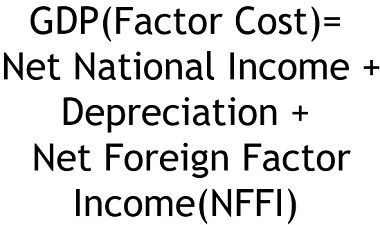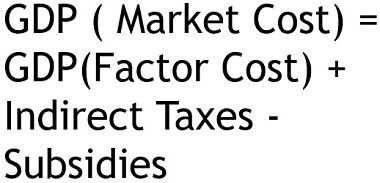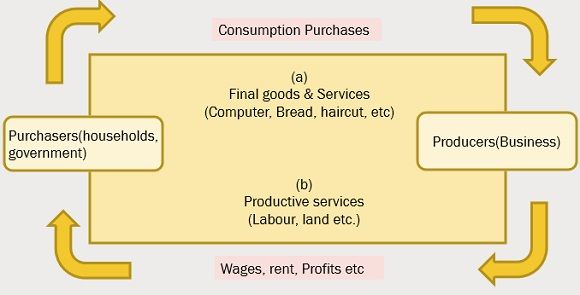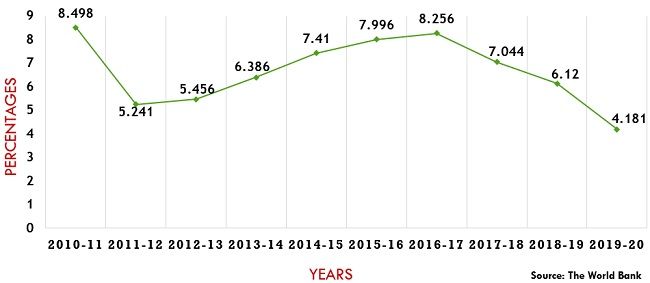Definition: Gross Domestic Product (GDP) is the total market value of the services and final goods formed within a nation’s boundaries in a financial year. It is used to measure the comprehensive achievement of an economy. The nations’ GDP growth is calculated with an increase in the GDP from the previous year to the current year, which can be calculated yearly or quarterly.
While calculating GDP growth rate on quarterly basis GDP of last year’s same quarter is compared with the GDP of current year same quarter. For example, the GDP of April-June 2019 will be compared with April- June 2020 and so on for the remaining quarters.
On the contrary, in annual GDP calculation, last year’s GDP is compared with the current year GDP. For example, the GDP of 2017-18 will be compared with the GDP of 2018-19.
Content: Collective Bargaining
- Annual Growth Rate Chart of Gross Domestic Product (GDP) of India from 2011-12 to 2019-20
- Factors of Gross Domestic Product(GDP)
- Ways of Calculating Gross Domestic Product(GDP)
- Measures of Gross Domestic Product(GDP)
- Explanatory Chart of Calculating Real and Nominal GDP
- GDP Deflator
- What is Inflation?
- Drawbacks of Gross Domestic Product(GDP)
- Points to Remember
- Conclusion
Annual Growth Rate Chart of Gross Domestic Product (GDP) of India from 2011-12 to 2019-20
Factors of Gross Domestic Product (GDP)
Following are the two factors of the GDP:
1. Nominal GDP: Nominal GDP is a value evaluated by multiplying the total number of final goods and services produced during the year with the current market price of such goods and services in that year. It rises with an increase in the production quantity or with an increase in the price of such goods and services. However, while computing nominal GDP, all inflationary and deflationary measures are taken into effect. Thus, it is not a better measure of economic growth.
2. Real GDP: Real GDP is valued on the constant price; thus, it shows the Gross Domestic Product that adjusts for Inflation or Deflation. It is evaluated by multiplying the total number of goods and services produced during the year with the selected base year’s prices. Here base year implies the year of comparison taken as a base for calculating the GDP. Currently, a base year which is considered for computing the real GDP of India is of 2011-12.
Real GDP only increases with an increase in the quantity produced as prices are always constant while computing it. It is a better indicator of economic growth or production because it does not consider price effect but shows the actual production.
Ways of Calculating Gross Domestic Product (GDP)
Income Approach
In this approach, we calculate the income earned by all the factors production (Inputs which goes into producing final products). Majorly there are four factors of production –
- Labour (Includes wages earned by them)
- Land (Rent earned by the land)
- Capital (Return on capital in the form of interest)
- Management (Business profit earned by the management)
In India from 2015, we refer to GDP market cost as India’s GDP, before that GDP factor cost was considered GDP of India. The formula for Both the factors are as follows-
Formula for GDP at Factor Cost

Where;
NFFI = Income earned by the rest of the world in this country minus (-) income earned by this country in the rest of the world.
Formula for GDP at Market Cost

Expenditure Approach
Sum of money spent on goods and services comes under the expenditure approach. The formula for finding GDP with the following method is as follows-
Formula

Where;
C = Monetary value of consumption
I = Gross Investment
G = Acquisition of goods and services by the government.
X = Net exports produced within a nation during the year.
Measures of Gross Domestic Product(GDP)
Following are the measures of the GDP:

The flow of final products, as a flow of earning or incomes are the systematic ways to find GDP. It can be understood easily with the help of the above diagrammatical representation.
In the upper curve, customers buy goods and services, and the total flow of money which they spend every year is one measure of GDP. The lower curve, shows the annual flow of output cost, the revenue that business pay-off in interest, wages, dividends, rent, profit.
These two measures should always be identical.
Explanatory Chart of Calculating Real and Nominal GDP
Example
| 2017-2018 | 2018-2019 | |
|---|---|---|
| Production | 20000 tonnes | 24000 tonnes |
| Nominal GDP= | Current year production*Current year price= | 24000*150=36,00,000 |
| Real GDP= | Current year production*Base year price= | 24000*100=24,00,000 |
Calculation of percentage (%) increase in Real and Nominal GDP in current year
Last year production value = 20000 tones*100 rupees = 20,00,000
Real GDP = 24000 tones*100rupees = 24,00,000 (% Increase (+) 20%)
Nominal GDP = 24000*150 rupees = 36,00,000 (% Increase (+) 80%)
GDP Deflator
- The GDP deflator is a measurement deflator of inflation in the economy.
- It can be used to compare the performance of the two economies, and various investment decisions are taken with the help of GDP deflator.
- The government also uses it to draft their policies.
- The GDP deflator is a ratio from real to nominal GDP or visa-versa.
Formula

Where;
GDPN = GDP at Nominal price
GDPR = GDP at Real price
To understand it properly it is important to know,
What is Inflation?
By inflation we mean, time of generally rising prices in the economy, and it can be of two types-
1. Demand-Pull Inflation: It is an Inflation that usually happens because of aggregate demand, i.e. when aggregate demand is higher than aggregate supply in the economy their will a deficit of commodities (Demand > supply), and it will be treated as demand-pull Inflation.
2. Cost-Pull Inflation: Cost pull inflation arises because of increase or push in the production cost. It increases inflation because of which commodities in the market also become expensive, and their market prices increase.
Drawbacks of Gross Domestic Product (GDP)
Following are some of the drawbacks of GDP:
- It does not include underground money; i.e. Black money floating in the market does not include in the calculation of the nation’s GDP.
- Non- Market production not measured as goods and services produced but not exchanged for money does not include in GDP calculation.
For Example: If an individual plants vegetable for their personal consumption, its value will not include in GDP, but when you purchase or buy it from the market, it will include in GDP calculation.
- Changes in quality may not be included in GDP because it is difficult to attribute the change in price to change in quality.
Points to Remember
- GDP comprises of two-factors, i.e., Nominal GDP and Real GDP.
- GDP can be calculated with the two approaches, i.e., the income approach, and the expenditure approach.
- GDP only includes finished goods price and not intermediate goods price.
- Capital goods will be included in calculating GDP, irrespective of being intermediate goods. Example: A tractor (capital good) is used by the farmer for producing potatoes (finished goods).
Conclusion
GDP of a country includes a product and services produced within its boundaries. Thus, the products manufactured in India and exported to other countries will be considered in calculating the nation’s GDP for the year, whereas; items imported from outside India will not be included in GDP calculations.

Leave a Reply